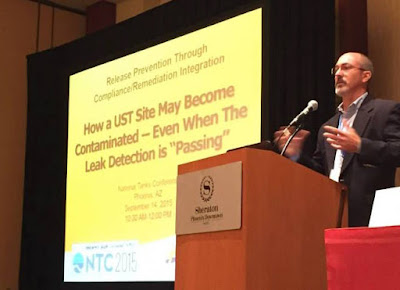
The 26th National Tanks Conference & Exposition, hosted by The New England Interstate Water Pollution Control Commission (NEIWPCC), was held on Sept. 11-13 in Louisville, Kentucky.
Federal and state regulators, manufacturers, environmental firms, fuel marketers, testing companies and industry associations attended the conference to learn what stakeholders are thinking about, what they are talking about and what may be ahead. Here are the highlights, as reported in the
PEI TulsaLetter.
Sump Testing. State regulators continue to wrestle with sump testing options. The hydrostatic testing method recommended in PEI/RP1200: Recommended Practices for the Testing and Verification of Spill, Overfill, Leak Detection and Secondary Containment Equipment at UST Facilities and endorsed by the U.S. Environmental Protection Agency (EPA) in the 2015 federal underground storage tank (UST) regulations is or will be recognized in most states. When alternative low-water-level test methods are allowed, they often are subject to requirements beyond those in the technical compendium accompanying the 2015 federal rule. New Mexico, for example, allows low-water-level testing in only limited circumstances. The PEI/RP1200 hydrostatic test must be used at the time of sump installation and on every fourth three-year inspection (i.e., every 12 years). States also are implementing penalties for owners and operators who inappropriately tamper with the sensor used in low-level sump testing.
Aging UST Systems. Regulators are growing more concerned about the risks associated with tanks that have reached the end of their 30-year warranty. Several regulators and industry professionals wanted to discuss a suggestion PEI made recently in the PEI Journal and the L.U.S.T.Line : that states should work together closely to compile and aggregate data on their UST systems. Comparable data on tank age, type and the frequency and source of failures nationwide would increase the industry’s understanding of the risks associated with older tanks—and encourage better strategies for reducing those risks.
Internal Corrosion. Every regulator reported increased internal corrosion in gasoline and diesel UST systems. One conference presenter emphasized how temperatures above 76 degrees can accelerate the bacterial growth that is behind most corrosion. Expect more studies on the correlation between temperature and corrosion.
Emergency Generator Day Tanks. These tanks are gaining greater regulatory attention as their numbers increase and their risks become more apparent. In many cases, day tanks have no secondary containment, no overfill protection, are filled automatically and lack adequate venting. PEI expects increased state regulation of day tanks in the future, including greater reliance on the procedures in PEI/RP1400: Recommended Practices for the Design and Installation of Fueling Systems for Emergency Generators.







